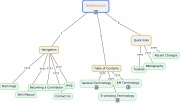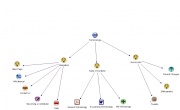Difference between revisions of "Mind Mapping"
From Learning and training wiki
| Line 22: | Line 22: | ||
=='''Practical Tips'''== | =='''Practical Tips'''== | ||
*Use single words or simple phrases, they can convey the same meaning of a long sentence but they are more potent. | *Use single words or simple phrases, they can convey the same meaning of a long sentence but they are more potent. | ||
| − | *Use | + | *Use colours to separate different concepts, this will make the map easy to remember and will help showing the organization of the subject. |
*Use symbols and images, that are easier to remember the words. | *Use symbols and images, that are easier to remember the words. | ||
*Use corss linkages, since information in one part of the drawing may relate with other on the other side of it.}} | *Use corss linkages, since information in one part of the drawing may relate with other on the other side of it.}} | ||
Revision as of 14:42, 10 October 2008
| A Learning methodology that consists of drawing diagrams used to represent words, ideas, tasks, processes or other items. It is a non-linear way of organizing information and a technique that allows to capture the natural flow of ideas. Each idea or fact is written down and then linked by lines or curves to its major or minor (or following or previous) idea or fact, thus creating a web of relationships. Its purpose is to focus attention, and to capture and frame knowledge to facilitate sharing of ideas and concepts.
Mind maps can be used to:
|
| In the table below there is a list of mindmapping tools. All of them are free-sources. You will also find some basic information about them, like if they are downoladable or only usable on-line, what kind of features and which degree of freedom in constructing the map they offer. By clicking the visualization image you will be able to see a sample map. |
| Tools | Type of Application | Special Features | Structure | Visualization |
|---|---|---|---|---|
| Freemind | To download
(1,51 KB) |
Link to files and web-sites | Ramification only horizontal. No freedom to change the structure. | |
| CMAP Tools | To downlad
(1,62 KB) |
Link to files and web-sites | Free structure. Every arrow connecting two nodes is supposed to contain a label | |
| Mindmeister | On-line. Two versions: Basic for free,
Premium to pay (4$ per month) |
Link to files and web-sites | Ramification only horizontal. No freedom to change the structure. | |
| Bubbl.us | On-line | Link to web-sites, impossible to link files | Free structure | |
| VUE | To download
(1,51 KB) |
Link to files and web-sites | Free structure. Possibility two add a label on the connection between two nodes. | |
| Compendium | To download
(1,58 KB) |
Link to files and web-sites | Free structure. Every node has to belong to a cathegory (question, decision, argument, idea..) | |
| Wisemapping | On-line | Link to web-sites, impossible to link files | Ramification only horizontal. No freedom to change the structure. | |
| Mind42 | On-line | Link to web-sites, impossible to link files | Ramification only horizontal. No freedom to change the structure. |
References
- ↑ astd-cac.net (08 July 2008) Wikipedia(08 July 2008) www.mind-mapping.co.uk (08 July 2008), www.illumine.co.uk (08 July 2008), www.mindtools.com (08 July 2008), www.thinksmart.com (8 October 2008), www.mindtools.com (8 October 2008), www.businessdictionary.com (8 October 2008)





